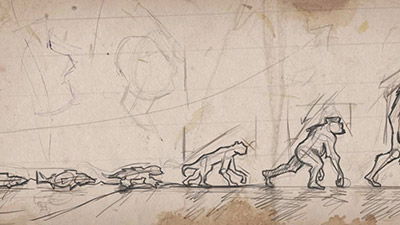
Instantaneous Evolution
Early humans weren’t very good at swinging from trees. But if you think that has evolutionists doubting human evolution, think again.
News Source
- Science: “Our Ancestors Were No Swingers”
Even evolutionists admit that the transition from ape to apeman to man contains plenty of guesswork and speculation. One of the ongoing debates in evolutionary circles is what the first step (so to speak) was for the earliest true humans: to “spen[d] some time in the trees even as they adapted to their new ground-dwelling lifestyle,” or whether “our distant ancestors’ arms, legs, and feet were more humanlike than apelike and poorly adapted for climbing.” The debate can be restated as a question: how quickly did tree-dwelling apes (allegedly) evolve into ground-dwelling humans?
How quickly did tree-dwelling apes (allegedly) evolve into ground-dwelling humans?
Worcester State College anthropologist Jeremy DeSilva decided filming chimpanzees could advance the debate—an obvious reflection of his evolutionary presuppositions. In Uganda’s Kibale National Park, DeSilva recorded chimps’ anatomical movements as they climbed around in trees. The chimps flex their ankles by raising their feet some 45 degrees from the resting position—far more than humans could do without suffering serious injury. Instead, humans bend their ankles 15 to 20 degrees at most when attempting the equivalent action.
Next, DeSilva examined a variety of ape and human fossils, looking at the main bones that compose the ankle joint (the tibia and talus bones). His study shows that “all of the hominin [i.e., human fossil] ankle joints resembled those of modern humans rather than those of apes.” That’s no surprise to creationists!
Of course, this news doesn’t necessarily change the minds of any evolutionists. Some, such as Stony Brook University anthropologist William Jungers, point out that modern humans can still climb trees without such ankle-flexing capacity. But DeSilva doesn’t think early humans could have been simultaneously good at ground-walking and tree-climbing, instead concluding that “full bipedalism would have evolved relatively rapidly as tree-climbing ability declined,” ScienceNOW reports.
Perhaps human bipedalism “evolved” even more quickly than DeSilva suspects: instantaneously, as in at the instant that God created Adam. That’s what the evidence indicates—in this case, more evidence of the unique features and abilities of both apes and humans.
Further Reading
For More Information: Get Answers
Remember, if you see a news story that might merit some attention, let us know about it! (Note: if the story originates from the Associated Press, FOX News, MSNBC, the New York Times, or another major national media outlet, we will most likely have already heard about it.) And thanks to all of our readers who have submitted great news tips to us. If you didn’t catch all the latest News to Know, why not take a look to see what you’ve missed?
(Please note that links will take you directly to the source. Answers in Genesis is not responsible for content on the websites to which we refer. For more information, please see our Privacy Policy.)

Answers in Genesis is an apologetics ministry, dedicated to helping Christians defend their faith and proclaim the good news of Jesus Christ.
- Customer Service 800.778.3390
- Available Monday–Friday | 9 AM–5 PM ET
- © 2025 Answers in Genesis



